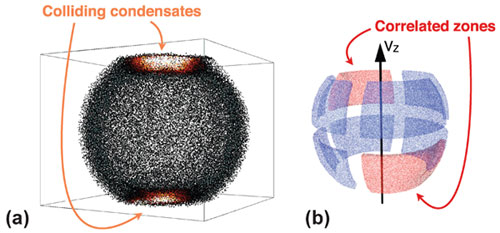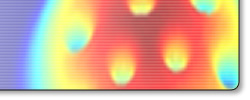Beating the standard quantum limit on noise with ultra-cold atoms
29 Dec 2010
An international team of researchers involving Dr Karen Kheruntsyan from the University of Queensland node of ACQAO and his colleagues from France and Poland have produced a source of pair-correlated atoms that beats the standard quantum limit on noise.
The correlated atoms were produced by colliding two Bose-Einstein condensates (BECs) of metastable helium (see Fig. 1a) and were shown to possess sub-Poissonian fluctuations in the relative atom number. The results were reported in the November 5 issue of the Physical Review Letters 105, 190402 (2010).
The condensate collision experiments were performed in the ultra-cold atom laboratory of Profs Chris Westbrook and Alain Aspect of the Institute d’Optique – members of the ACQAO partner institute IFRAF in France. Dr Kheruntsyan, alongside with Dr P. Deuar of the Institute of Physics, Polish Academy of Sciences, have provided theoretical support to the experiments.
 (a) View of the halo of scattered atoms after the collision of two BECs. (b) The analysed part of the halo, divided into eight zones. An example of two correlated zones is shown in red (arrows). The atom number difference between these two zones have sub-Poissonian statistics.
(a) View of the halo of scattered atoms after the collision of two BECs. (b) The analysed part of the halo, divided into eight zones. An example of two correlated zones is shown in red (arrows). The atom number difference between these two zones have sub-Poissonian statistics.
Sources of ultra-cold atoms with fluctuations lower than the standard quantum limit hold a significant promise for the use in atom interferometers for precision measurement. Such interferometers can be used, for example, to detect miniscule gravitational fields or in rotational and acceleration sensors. In addition, such sources are well suited for performing fundamental tests of quantum mechanics in new regimes, such as the Einstein-Podolsky-Rosen-type nonlocality tests using a macroscopic number of massive particles. Such tests were so far performed only with massless photons, but never with ensembles of massive particles.
Read full paper: Sub-Poissonian Number Differences in four-wave mixing of matter waves.
J.-C. Jaskula, M. Bonneau, G. B. Partridge, V. Krachmalnicoff, P. Deuar, K. V. Kheruntsyan, A. Aspect, D. Boiron, and C. I. Westbrook, Phys. Rev. Lett. 105, 190402 (2010).
Media: for further information, contact Dr Karen Kheruntsyan, karen.kheruntsyan uq.edu.au, +61 7 33653420 or +61 7 33716832. uq.edu.au, +61 7 33653420 or +61 7 33716832.
|

